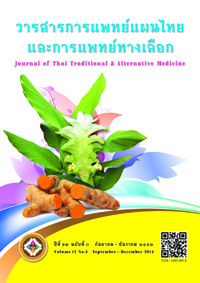Contaminants and Residues of Herbal Drugs: Quality Control in Thai Pharmacopoeia
Main Article Content
Abstract
This article outlines the quality control of herbal drugs in the aspect of contaminants and residues. It describes the types and dangers of the contaminants and residues which are toxic heavy metals, mycotoxins, radionuclides, pesticide residues and microbial contaminations. Such contaminants and residues may diminish the quality of herbal drugs and harm consumers. In addition, this article also mentions about the requirements of quality control related to contaminants and residues in herbal drugs stated in the Thai Herbal Pharmacopoeia as well as the WHO guidelines.
Article Details
Section
Review Article
References
1. World Health Organization. Quality control methods for medicinal plant meterials. Geneva: WHO Press; 1998. p. 47-74
2. World Health Organization. WHO guidelines for assessing quality of herbal medicines with reference to contaminants and residues. Geneva: WHO Press; 2007. 105 pages.
3. นันทนา สิทธิชัย. มาตรฐานของสมุนไพรในตำรามาตรฐานยาสมุนไพรไทย. วารสารสมุนไพร. 2547;11(1):21-32.
4. Department of Medical Sciences, Ministry of Public Health. Thai Herbal Pharmacopoeia, Vol. III. Bangkok: Office of National Buddishm Press; 2009. p. 5, 162-9.
5. Hutton M. Human health concerns of lead, mercury, cadmium and arsenic. In: Huntchinson TC, Meema KM, editors. Lead, mercury, cadmium and arsenic in the environment. Chichester, New York, Brisbane, Toronto: John Wiley & Sons Ltd; 1987. p. 53-68.
6. Department of Medical Sciences, Ministry of Public Health. Thai Pharmacopoeia II. Banngkok: Office of National Buddishm Press; 2011. p. 474-80, 621-39.
7. กรวิกา จารุพันธ์. การตรวจสอบอะฟลาทอกซินในยาสมุนไพรตามฟาร์มาโคเปีย. สารตำรายา. 2553;17(3):98-109.
8. European directorate for the quality of medicines & healthcare. European Pharmacopoeia, Vol. 1. 7th ed. Starsbourg: Council of Europe; 2010. p. 242-3.
9. Peter AGM de Smet. Overview of herbal quality control. Drug Inf J. 1999;33:717-24.
10. Department of Medical Sciences, Ministry of Public Health. Thai Pharmacopoeia I, Vol. I, Part 1. Bangkok: WVO Office of Printing Mill; 1987.p. 35-6.
11. Surekha D, Rajan VST, Kumar NA, Parameswari SA, Chetty CM. A review on role of quality control and quality assurance system in regulation of herbal drugs. Int J Rev Life Sci. 2011;1(3):97-105.
12. Parthik P, Patel NM, Patel PM. WHO guidelines on quality control of herbal medicines. IJRAP. 2011;2(4):1148-54.
13. สำนักระบาดวิทยา กรมควบคุมโรค กระทรวงสาธารณสุข. สถานการณ์และผลต่อสุขภาพจากการสารเคมีป้องกันกำจัดศัตรูพืช ปี พ.ศ. 2556. รายงานการเฝ้าระวังทางระบาดวิทยาประจำสัปดาห์. 2556;44(44):689-92.
14. สุเทพ เรืองวิเศษ. พิษวิทยาของสาร Organophosphorus. สารตำรายา. 2536;1(2):21-33.
15. Farber JM, Carter AO, Varughese PV, Ashton FE, Ewan EP. Listeriosis traced to the consumption of alfalfa tablets and soft cheese . New Engl J Med. 1990;322:338.
16. อรุณณี จันทกิจ, วิลาวัลย์ สุนทรารักษ์, วุฒิศักดิ์ คณาวุฒิ. การปนเปื้อนของเชื้อจุลินทรีย์ในยาแผนโบราณ. สารตำรายา. 2541;6(3):88-95.
17. สันติพงศ์ วงศ์เพ็ญทักษ์, ลัดดา พลูสวัสดิ์, อนัญญา สุพันธุ์วณิช. การศึกษาการปนเปื้อนเชื้อจุลินทรีย์ของยาจากสมุนไพรที่ขอขึ้นทะเบียนยายาแผนโบราณในประเทศไทย. สารตำรายา. 2554;18(1):1-12.
18. Wikipedia the free encyclopedia. Pathogenic bacteria. (serial online) [cited 2014 May 10]; [1 screens]. Available from: URL: http://en.wikipedia.org/wiki/Pathogenic_bacteria
19. สถาบันการแพทย์แผนไทย กรมพัฒนาการแพทย์แผนไทยและทางเลือก กระทรวงสาธารณสุข. หลักเกณฑ์ขององค์การอนามัยโลก เกี่ยวกับเกษตรและการเก็บเกี่ยวดีที่เหมาะสมสำหรับพืชสมุนไพร. พิมพ์ครั้งที่ 1. กรุงเทพมหานคร: โรงพิมพ์องค์การรับส่งสินค้าและพัสดุภัณฑ์ (ร.ส.พ.); 2548. จำนวน 74 หน้า.
20. Tassaneeyakul W, Razzazi-Fazeli E, Porasuphatana S, Bohm J. Contamination of aflatoxins in herbal medicinal products in Thailand. Mycopathologia. 2004;158: 239-44.
2. World Health Organization. WHO guidelines for assessing quality of herbal medicines with reference to contaminants and residues. Geneva: WHO Press; 2007. 105 pages.
3. นันทนา สิทธิชัย. มาตรฐานของสมุนไพรในตำรามาตรฐานยาสมุนไพรไทย. วารสารสมุนไพร. 2547;11(1):21-32.
4. Department of Medical Sciences, Ministry of Public Health. Thai Herbal Pharmacopoeia, Vol. III. Bangkok: Office of National Buddishm Press; 2009. p. 5, 162-9.
5. Hutton M. Human health concerns of lead, mercury, cadmium and arsenic. In: Huntchinson TC, Meema KM, editors. Lead, mercury, cadmium and arsenic in the environment. Chichester, New York, Brisbane, Toronto: John Wiley & Sons Ltd; 1987. p. 53-68.
6. Department of Medical Sciences, Ministry of Public Health. Thai Pharmacopoeia II. Banngkok: Office of National Buddishm Press; 2011. p. 474-80, 621-39.
7. กรวิกา จารุพันธ์. การตรวจสอบอะฟลาทอกซินในยาสมุนไพรตามฟาร์มาโคเปีย. สารตำรายา. 2553;17(3):98-109.
8. European directorate for the quality of medicines & healthcare. European Pharmacopoeia, Vol. 1. 7th ed. Starsbourg: Council of Europe; 2010. p. 242-3.
9. Peter AGM de Smet. Overview of herbal quality control. Drug Inf J. 1999;33:717-24.
10. Department of Medical Sciences, Ministry of Public Health. Thai Pharmacopoeia I, Vol. I, Part 1. Bangkok: WVO Office of Printing Mill; 1987.p. 35-6.
11. Surekha D, Rajan VST, Kumar NA, Parameswari SA, Chetty CM. A review on role of quality control and quality assurance system in regulation of herbal drugs. Int J Rev Life Sci. 2011;1(3):97-105.
12. Parthik P, Patel NM, Patel PM. WHO guidelines on quality control of herbal medicines. IJRAP. 2011;2(4):1148-54.
13. สำนักระบาดวิทยา กรมควบคุมโรค กระทรวงสาธารณสุข. สถานการณ์และผลต่อสุขภาพจากการสารเคมีป้องกันกำจัดศัตรูพืช ปี พ.ศ. 2556. รายงานการเฝ้าระวังทางระบาดวิทยาประจำสัปดาห์. 2556;44(44):689-92.
14. สุเทพ เรืองวิเศษ. พิษวิทยาของสาร Organophosphorus. สารตำรายา. 2536;1(2):21-33.
15. Farber JM, Carter AO, Varughese PV, Ashton FE, Ewan EP. Listeriosis traced to the consumption of alfalfa tablets and soft cheese . New Engl J Med. 1990;322:338.
16. อรุณณี จันทกิจ, วิลาวัลย์ สุนทรารักษ์, วุฒิศักดิ์ คณาวุฒิ. การปนเปื้อนของเชื้อจุลินทรีย์ในยาแผนโบราณ. สารตำรายา. 2541;6(3):88-95.
17. สันติพงศ์ วงศ์เพ็ญทักษ์, ลัดดา พลูสวัสดิ์, อนัญญา สุพันธุ์วณิช. การศึกษาการปนเปื้อนเชื้อจุลินทรีย์ของยาจากสมุนไพรที่ขอขึ้นทะเบียนยายาแผนโบราณในประเทศไทย. สารตำรายา. 2554;18(1):1-12.
18. Wikipedia the free encyclopedia. Pathogenic bacteria. (serial online) [cited 2014 May 10]; [1 screens]. Available from: URL: http://en.wikipedia.org/wiki/Pathogenic_bacteria
19. สถาบันการแพทย์แผนไทย กรมพัฒนาการแพทย์แผนไทยและทางเลือก กระทรวงสาธารณสุข. หลักเกณฑ์ขององค์การอนามัยโลก เกี่ยวกับเกษตรและการเก็บเกี่ยวดีที่เหมาะสมสำหรับพืชสมุนไพร. พิมพ์ครั้งที่ 1. กรุงเทพมหานคร: โรงพิมพ์องค์การรับส่งสินค้าและพัสดุภัณฑ์ (ร.ส.พ.); 2548. จำนวน 74 หน้า.
20. Tassaneeyakul W, Razzazi-Fazeli E, Porasuphatana S, Bohm J. Contamination of aflatoxins in herbal medicinal products in Thailand. Mycopathologia. 2004;158: 239-44.


